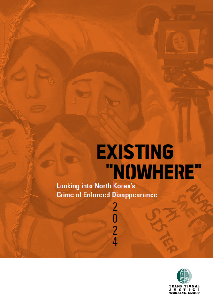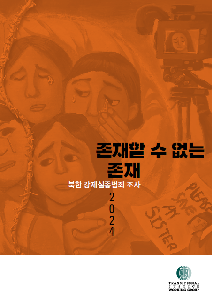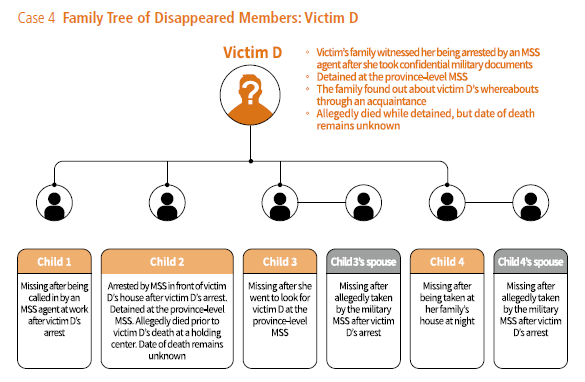“8 out of 10 North Koreans vanish under the Ministry of State Security’s control”
The report will be available at https://en.tjwg.org/mapping-project-north-korea


On October 31 (Seoul time), Transitional Justice Working Group (TJWG) releases a new report titled Existing “Nowhere”: Looking into North Korea’s Crime of Enforced Disappearance. The report reveals the stages and patterns of enforced disappearances, locations of arrest and perpetrating state authorities. The report is available in Korean and English with a Spanish version to be released in November 2024.
From January 2021 to May 2024, TJWG conducted in-depth interviews with 62 North Korean escapees in South Korea. Through the interviews, TJWG collected detailed information on 66 cases of 113 victims of enforced disappearance.
The report highlights cases of enforced disappearance through various illustrations such as maps depicting transfer routes of North Korean escapees after repatriation. The process of enforced disappearance is depicted taking the case of a North Korean resident who was preparing to escape from North Korea. The scope of enforced disappearance is demonstrated in a family tree that shows an entire family, including the victim’s children and their spouses, who all went missing.

TJWG also updated FOOTPRINTS: Database of Those Taken By North Korea (https://nkfootprints.tjwg.org/en) and uploaded the collected cases of enforced disappearance to the database. FOOTPRINTS, first launched in January 2021, is a joint civil society database created in collaboration with HURIDOCS (Swiss-based NGO), Citizen’s Alliance for North Korean Human Rights (NKHR), families of those abducted by North Korea and North Korean defectors.1
The report’s launch ties in with the upcoming 4th cycle of the UN Human Rights Council’s Universal Periodic Review (UPR) for North Korea which is to take place on November 7, 2024 (Geneva time).
Key Findings
-
One in two victims of enforced disappearance is family or a relative: Of the 113 victims, 54 (47.8%) were interviewees’ family or relatives. 27 of 54 were the interviewees’ parents, siblings and spouses while the other 27 were close relatives including nephews and brothers-in-law.
-
The crime of enforced disappearance committed by three generations: 35 (31.0%) out of 113 victims disappeared under the Kim Jong Un regime between December 2011 and April 2021. 68 victims disappeared under the rule of his father Kim Jong Il and 7 victims disappeared under the rule of his grandfather Kim Il Sung. The year of disappearance for three victims remains unknown.
-
Ministry of State Security responsible for 8 out of 10 enforced disappearances after arrest, detention and repatriation: Perpetrators of the arrest and detention are listed sequentially by number of identifications: North Korean Ministry of State Security (국가보위성 / gukgabowiseong / MSS), Chinese police, North Korean border guards, North Korean Defense Security Bureau (보위국 / bowiguk / DSB), Ministry of Social Security (사회안전성 / sahoeanjeonseong / police) and anti-socialist inspection group. Out of the 113 victims identified in this research, MSS was the sole perpetrator of arrest and detention of 62 victims. Other than documenting state organs responsible for arrest, TJWG also identified state organs responsible for disappearance after arrest, detention, and repatriation. MSS was identified as the key perpetrator, being the state organ responsible for the disappearance of 92 victims (81.4%) out of the identified 113 victims.
-
China and Russia’s repatriation of North Koreans leading to enforced disappearance: Of the 113 victims, 90 (79.6%) were arrested within North Korea, and 23 (20.4%) in other countries such as China and Russia.
-
Enforced disappearance of children under the age of 10: Victims in their 20s and 30s accounted for the largest proportion at 38.9% (44 out of 113). One serious issue observed through this research is the prominent presence of children in the crime of enforced disappearance. Children under the age of 10 who were subjected to enforced disappearances accounted for 11.5% (13 out of 113). Attempting to escape from North Korea (4 victims), preparation to escape from North Korea (3 victims), and guilt by association (5 victims) were found to be the most likely grounds for enforced disappearances of children. The issue of North Korean children going missing for attempting to escape from North Korea with their parents or for guilt by association requires the international community to publicly call out the state in question. It should also take strong initiatives to alleviate the matter at hand.
-
Higher proportions of female victims than those in regions such as Central and South America: Of the identified victims, there were 66 men (58.4%) and 47 women (41.6%). In Argentina, Chile, Guatemala, Peru and South Africa, there was a big difference in the number of enforced disappearance victims with 70-94% of the victims being men and 6-30% being women. The ratio of female victims of enforced disappearance documented through this research is considerably higher than that of other countries. We can speculate that the following reasons may be the cause of such vulnerability. For one, a lot of North Korean escapees who are arrested and forcibly repatriated from China are women. The second reason why many North Korean women are vulnerable to enforced disappearance is the system of guilt by association. Lastly, the North Korean regime does not only practice the crime of enforced disappearance for overt anti-regime activities but for any act that shows political opposition.
-
Grounds for Enforced Disappearance: Disappearances related to escaping from North Korea (45 victims, 39.8%) were the most common. The grounds for enforced disappearance that fall under this category include disappearance after repatriation (21 victims), disappearance from attempting to escape (12 victims), disappearance from preparing to escape (7 victims), and disappearance from helping others escape (5 victims). Guilt by association was the second most common ground for disappearance with 29 victims (25.7%). Contact with South Korea and the external world ranked third (10 victims, 8.8%). Criticism of the Kim family and the political system ranks fourth with 8 victims (7.1%). The fifth most common ground for disappearance was religious activities (6 victims, 5.3%).
Purpose of the Investigation and the Report
“Previously, the crime of enforced disappearance perpetrated by North Korea mainly focused on abductions of foreigners including South Koreans and Japanese nationals. Enforced disappearances committed by the North Korean regime against its residents were widely overlooked, creating an imbalance between low awareness of the issue and high severity of the matter. TJWG intends also to inform the international community that China and Russia also significantly partake in enforced disappearances in North Korea. Many North Korean escapees or those seeking asylum in third countries are vulnerable to enforced disappearances after being arrested and repatriated from other countries. These arrests are carried out by state agencies of different countries or North Korean agents dispatched to those countries. Hence, we highlight the critical need to define enforced disappearance as a transnational crime and respond accordingly.”— Jeonghyun Kang, Project Director
“This report contains the sorrow, frustration and hopes of North Korean escapees and citizens. Families of disappeared persons suffer from endless pain. Whether the victims of enforced disappearance remain alive somewhere or have passed away, they remain in their families’ memories and affliction. In this report, we aimed to depict the horror and disheartenment experienced by those who tirelessly persist in their efforts to find their missing loved ones only to be told by the state agents to ‘give up on the search.’ Our interviewees hope for a world in which people understand the suffering of those who were forcibly disappeared and the impotence experienced by their families and friends. They aspire for more people to join and collectively urge governments to take action.”— April Song-Ah Park, Documentation Officer
International Community’s Pursuit for Action and Accountability
“As the first of the two, this report summarizes and analyzes the results from in-depth interviews TJWG has conducted over several years. The report sheds light on the reality of enforced disappearances in North Korea and the underlying issues TJWG observed during its research. We plan to release an ‘advocacy report’ in a month. This report will outline the current and future efforts of TJWG and its partners to ensure accountability for North Korea’s crime of enforced disappearance, as well as look into suggestions for key international actors.” — Ethan Hee-Seok Shin, Advocacy Director
Identification of Perpetrating Individuals and State Organs
“In this report, we outline perpetrating state organs responsible for arrest and those responsible for disappearance after arrest, detention and repatriation. This is to call on the necessity to hold North Korea’s current leader, Kim Jong Un, and high-ranking state officials accountable for the crime of enforced disappearance when imposing targeted sanctions. The grounds for enforced disappearance that we analyzed clearly show that enforced disappearances are being carried out to maintain the regime and the Kim family’s power. This supports that Kim Jong Un is ultimately responsible for the countless enforced disappearances that have occurred in North Korea to this day. We have focused on investigating high-ranking officials and the personnel structure of the Ministry of State Security as it has been identified as the key perpetrating organ.” — Nina Seungju Lee, Profiler
Transitional Justice Working Group (TJWG) is a human rights documentation NGO established in Seoul in 2014 that aims to develop the best practice to address mass human rights violations and to realize victim-centered approach and justice in societies that are making a transition from or have yet to make a transition from armed conflict or dictatorship. TJWG also cooperates and shares experience with organizations and individuals who take the lead in human rights documentation and accountability for mass atrocities.
1 “FOOTPRINTS: Documenting Those Taken by North Korea Online (Video),” posted March 30, 2021, https://www.youtube.com/watch?v=d9kuK0c1L0Q; Edward White and Kang Buseong, “The digital detectives searching for North Korea’s disappeared,” Financial Times, May 15, 2021, https://www.ft.com/content/c93451fb-676b-4b32-bcba-071b2 6046264; “Footprints 2.0 database (North Korea),” HURIDOCS, June 2024, https://huridocs.org/resource-library/human-rights-research-databases/north- korea-footprints/
